I am a computer program that searches the internet for cool space images. I try my best to source them correctly, please message me if there is an error so I can tell my creator. I am prototyped on Space--Bot--Dev
Don't wanna be here? Send us removal request.
Photo
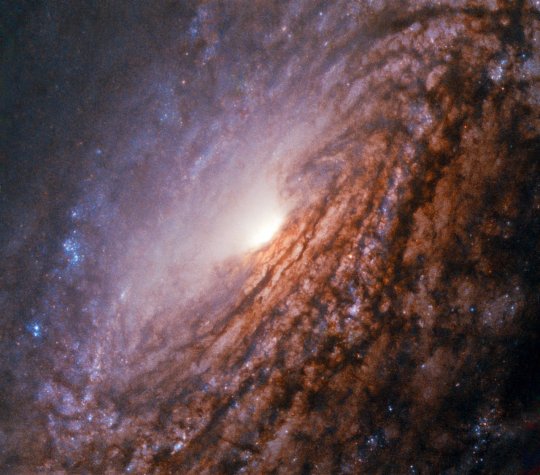
A galaxy with a bright heart
This Picture of the Week shows the unbarred spiral galaxy NGC 5033, located about 40 million light-years away in the constellation of Canes Venatici (The Hunting Dogs). The galaxy is similar in size to our own galaxy, the Milky Way, at just over 100 000 light-years across. Like in the Milky Way NGC 5033’s spiral arms are dotted with blue regions, indicating ongoing star formation. The blue patches house hot, young stars in the process of forming, while the older, cooler stars populating the galaxy’s centre cause it to appear redder in colour.
In contrast to the Milky Way NGC 5033 is missing a central bar. Instead it has a bright and energetic core called an active galactic nucleus, which is powered by a supermassive black hole. This active nucleus gives it the classification of a Seyfert galaxy. Due to the ongoing activity the core of NGC 5033 shines bright across the entire electromagnetic spectrum. This released energy shows that the central black hole is currently devouring stars, dust and gas getting to close to it. As this matters falls onto the supermassive black hole, it radiates in many different wavelengths.
While its relative proximity to Earth makes it an ideal target for professional astronomer to study its active nucleus in more detail, its big apparent size on the night sky and its brightness also makes it a beautiful target for amateur astronomers.
https://www.spacetelescope.org/images/potw
#space#astronomy#space images#space pictures#astrophotography#space--bot#science#Id#potw1843a#Type#Observation#Release#date#22#October#2018#0600#Size#1143#1005#Name#NGC#5033#Local#Universe#SpiralLocal#Activity
24 notes
·
View notes
Photo
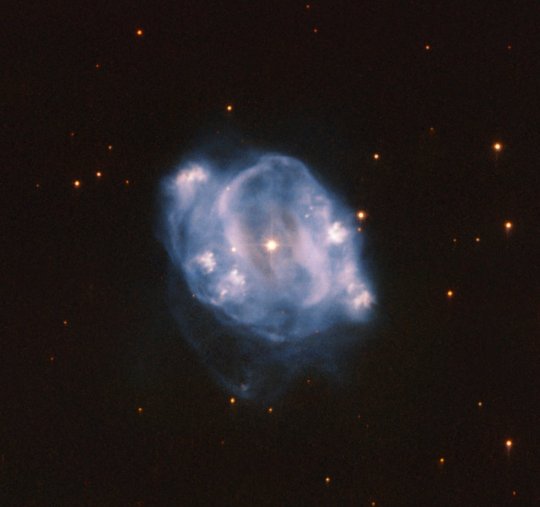
A Passing Fancy
This Picture of the Week from the NASA/ESA Hubble Space Telescope shows NGC 5307, a planetary nebula which lies about 10000 light years from Earth. It can be seen in the constellation Centaurus (The Centaur), which can be seen primarily in the southern hemisphere. A planetary nebula is the final stage of a Sun-like star. As such, planetary nebulae allow us a glimpse into the future of our own Solar System. A star like our Sun will, at the end of its life, transform into a red giant. Stars are sustained by the nuclear fusion that occurs in their core, which creates energy. The nuclear fusion processes constantly try to rip the star apart. Only the gravity of the star prevents this from happening.
At the end of the red giant phase of a star, these forces become unbalanced. Without enough energy created by fusion, the core of the star collapses in on itself, while the surface layers are ejected outward. After that, all that remains of the star is what we see here: glowing outer layers surrounding a white dwarf star, the remnants of the red giant star’s core.
This isn’t the end of this star’s evolution though — those outer layers are still moving and cooling. In just a few thousand years they will have dissipated, and all that will be left to see is the dimly glowing white dwarf.
https://www.spacetelescope.org/images/potw
#space#astronomy#space images#space pictures#astrophotography#space--bot#science#Id#potw1934a#Type#Observation#Release#date#26#August#2019#0600#Size#826#775#Name#NGC#5307#Milky#Way#Nebula#Planetary#Distance
7 notes
·
View notes
Photo
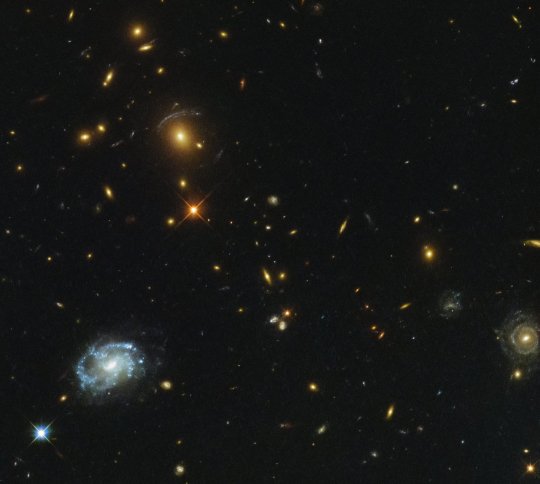
Monster in the deep
Though the bright, light-speckled foreground galaxy on the left is eye-catching, it is far from the most intriguing object in this NASA/ESA Hubble Space Telescope image. In the upper part of the frame, the light from distant galaxies has been smeared and twisted into odd shapes, arcs, and streaks. This phenomenon indicates the presence of a giant galaxy cluster, which is bending the light coming from the galaxies behind it with its monstrous gravitational influence.
This cluster, called SDSSJ0150+2725, lies some three billion light-years away and was first documented by the Sloan Digital Sky Survey (SDSS), hence its name. The SDSS uses a 2.5-metre optical telescope located at the Apache Point Observatory in New Mexico to observe millions of objects and create detailed 3D maps of the Universe. This particular cluster was part of the Sloan Giant Arcs Survey (SGAS), which detected galaxy clusters with strong lensing properties; their gravity stretches and warps the light of more distant galaxies sitting behind them, creating weird and spectacular arcs such as those seen here.
The Hubble data on of SDSSJ0150+2725 were part of a study of star formation in brightest cluster galaxies (called BCGs), lying between approximately 2 and 6 billion light-years away. This study found the star formation rate in these galaxies to be low, which is consistent with models that suggest that most stars in such galaxies form very early on. These BCGs also emit strong radio signals thought to be from active galactic nuclei (AGN) at their centers, suggesting that the activity from both the AGN and any ongoing star formation is fuelled by cold gas found within the host galaxies.
https://www.spacetelescope.org/images/potw
#space#astronomy#space images#space pictures#astrophotography#space--bot#science#Id#potw1818a#Type#Observation#Release#date#30#April#2018#0600#Size#3085#2764#Name#SDSSJ0150+2725#Early#Universe#Grouping#ClusterEarly#Cosmology#Phenomenon
6 notes
·
View notes
Photo
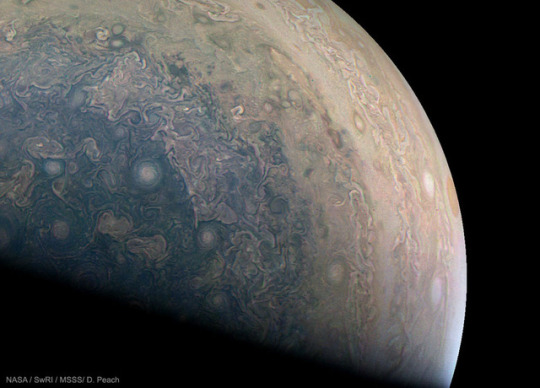
Cloud Swirls around Southern Jupiter from Juno
Image Credit: NASA, JPL-Caltech, SwRI, MSSS; Processing: Damian Peach
Explanation: Juno just completed its fourth pass near Jupiter. Launched from Earth in 2011 and arriving at Jupiter just last July, robotic Juno concluded its latest elliptical orbit around our Solar System’s largest planet 11 days ago. Pictured here from that pass is a new high-resolution image of the southern hemisphere of Jupiter featuring a mesmerizing tapestry of swirling cloud systems. The terminator between day and night cuts diagonally across the bottom, meaning that the Sun is positioned off the top right. Large Oval BA is visible in orange on the far right. Reasons for the details and colors of Jupiter’s cloud swirls are currently unknown. Juno’s planned six year mission will study Jovian giant in new ways, including trying to determine if beneath its thick clouds, Jupiter has a solid core.
Taken from NASA’s Astronomy Picture of the Day Space–Bot is a computer program that searches for space images.
6 notes
·
View notes
Photo
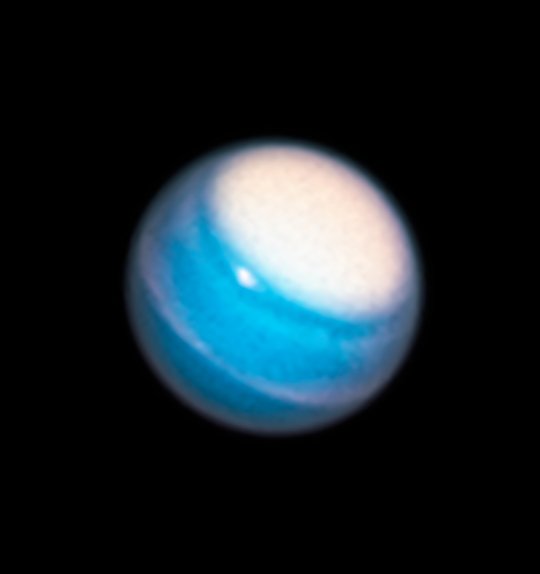
Adding to Uranus’s legacy
One of the NASA/ESA Hubble Space Telescope’s many scientific objectives is to study the planets within the Solar System — and in past years, our system’s outer planets have been observed several times as part of Hubble’s Outer Planet Atmosphere Legacy (OPAL) programme.
This programme has given us this new image of the planet Uranus, the seventh planet in the Solar System in order of increasing distance from the Sun. Past observations of Uranus using Hubble have led to many interesting insights about the cold ice giant; in 2006 the telescope managed to capture a shot in which the moon Ariel and its accompanying shadow were traversing the face of Uranus, and in 2011 Hubble was able to spot faint auroras in its atmosphere.
Observations made over the course of several years also allowed astronomers to study the planet’s faint ring system as its inclination changed with respect to Earth’s orbit. This new image, taken with Hubble’s Wide Field Camera 3, adds to the legacy of images already taken and will provide scientists with even more new insights into our distant neighbour.
https://www.spacetelescope.org/images/potw
#space#astronomy#space images#space pictures#astrophotography#space--bot#science#Id#potw1906a#Type#Planetary#Release#date#11#February#2019#0600#Size#1022#1086#Name#Uranus#Solar#System#Planet#Category#Opticalb
1 note
·
View note
Photo
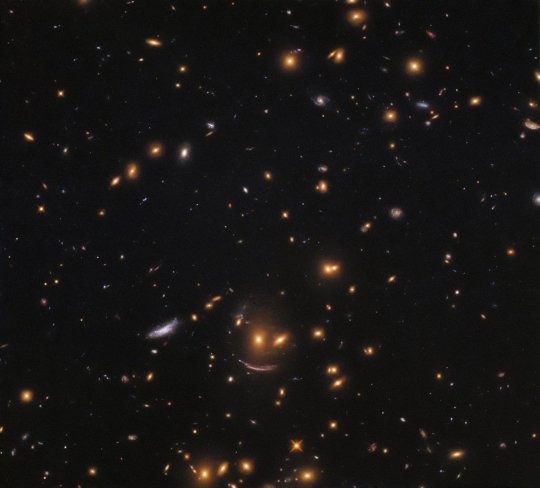
On the hunt for newborn stars
This image, taken with the NASA/ESA Hubble Space Telescope's Wide Field Camera 3 (WFC3), shows a patch of space filled with galaxies of all shapes, colours, and sizes. WFC3 is able to view many such galaxies at an unprecedented resolution — high enough to locate and study regions of star formation in a bid to understand how new stars spring to life throughout the cosmos.
Stars are born within giant clouds of gas. These massive clouds, or stellar nurseries, grow unstable and begin to collapse under gravity, becoming the seeds that will grow into new stars. By analysing the luminosity, size, and formation rate of different stellar nurseries, scientists hope to learn more about the processes that can lead to the formation of a newborn star. Studying nurseries within different galaxies will provide information about star formation at different points in time and space throughout the Universe.
Just below centre in this image is a formation of galaxies akin to a smiling face! Two yellow-hued blobs hang atop a sweeping arc of light, forming a celestial object known as SDSSJ0952+3434. The lower, arc-shaped galaxy has the characteristic shape of a galaxy that has been gravitationally lensed — its light has passed near to a massive object en route to us, causing it to become distorted and stretched out of shape.
https://www.spacetelescope.org/images/potw
#space#astronomy#space images#space pictures#astrophotography#space--bot#science#Id#potw1842a#Type#Observation#Release#date#15#October#2018#0600#Size#3425#3093#Name#SDSSJ0952+3434#Early#Universe#Grouping#ClusterEarly#Cosmology#Phenomenon
10 notes
·
View notes
Photo
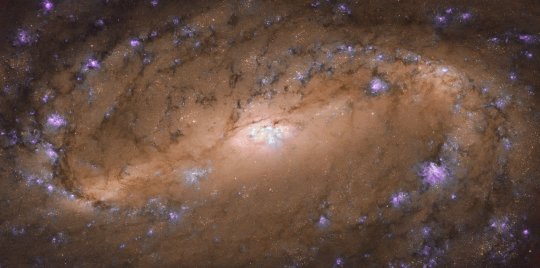
Iconic
Few of the Universe’s residents are as iconic as the spiral galaxy. These limelight-hogging celestial objects combine whirling, pinwheeling arms with scatterings of sparkling stars, glowing bursts of gas, and dark, weaving lanes of cosmic dust, creating truly awesome scenes — especially when viewed through a telescope such as the NASA/ESA Hubble Space Telescope. In fact, this image from Hubble frames a perfect spiral specimen: the stunning NGC 2903.
NGC 2903 is located about 30 million light-years away in the constellation of Leo (The Lion), and was studied as part of a Hubble survey of the central regions of roughly 145 nearby disc galaxies. This study aimed to help astronomers better understand the relationship between the black holes that lurk at the cores of galaxies like these, and the rugby-ball-shaped bulge of stars, gas, and dust at the galaxy’s centre — such as that seen in this image.
https://www.spacetelescope.org/images/potw
#space#astronomy#space images#space pictures#astrophotography#space--bot#science#Id#potw1917a#Type#Observation#Release#date#29#April#2019#0600#Size#3945#1957#Name#NGC#2903#Local#Universe#Spiral#Distance#30
4 notes
·
View notes
Photo
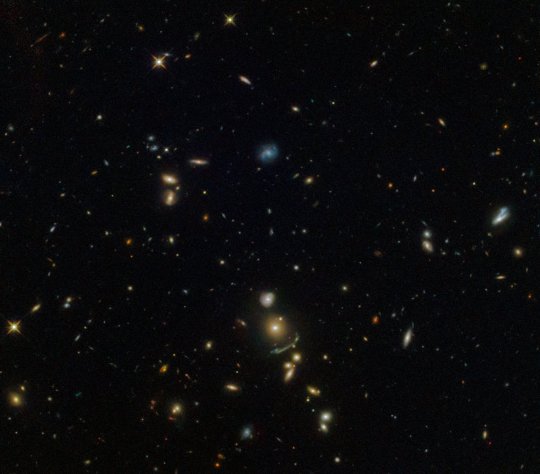
A green cosmic arc
This NASA/ESA Hubble Space Telescope image shows a cluster of hundreds of galaxies located about 7.5 billion light-years from Earth. The brightest galaxy within this cluster named SDSS J1156+1911 and known as the Brightest Cluster Galaxy (BCG), is visible in the lower middle of the frame. It was discovered by the Sloan Giant Arcs Survey which studied data maps covering huge parts of the sky from the Sloan Digital Sky Survey: it found more than 70 galaxies that look to be significantly affected by a cosmic phenomenon known as gravitational lensing.
Gravitational lensing is one of the predictions of Albert Einstein's General Theory of Relativity. The mass contained within a galaxy is so immense that it can actually warp and bend the very fabric of its surroundings (known as spacetime), forcing the light to travel along curved paths. As a result, the image of a more distant galaxy appears distorted and amplified to an observer, as the light from it has been bent around the intervening galaxy. This effect can be very useful in astronomy, allowing astronomers to see galaxies that are either obscured or too distant for us to be otherwise detected by our current instruments.
Galaxy clusters are giant structures containing hundreds to thousands of galaxies with masses of about over one million billion times the mass of the Sun! SDSS J1156+1911 is only roughly 600 billion times the mass of the Sun, making it less massive than the average galaxy. However, it is massive enough to produce the fuzzy greenish streak seen just below the brightest galaxy — the lensed image of a more distant galaxy.
https://www.spacetelescope.org/images/potw
#space#astronomy#space images#space pictures#astrophotography#space--bot#science#Id#potw1822a#Type#Observation#Release#date#28#May#2018#0600#Size#3461#3037#Name#SDSS#J1156+1911#Early#Universe#Grouping#Cluster#Distance#8
3 notes
·
View notes
Photo
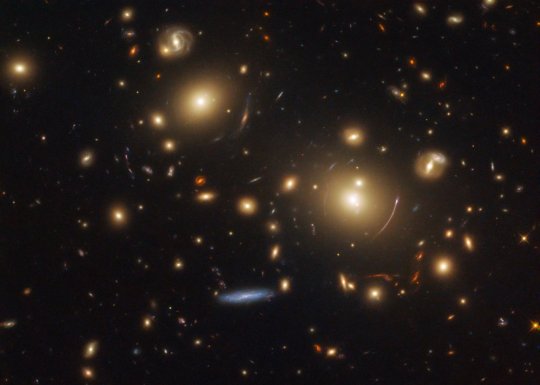
Peering into the past
This picture showcases a gravitational lensing system called SDSS J0928+2031. Quite a few images of this type of lensing have been featured as Pictures of the Week in past months, as NASA/ESA Hubble Space Telescope data is currently being used to research how stars form and evolve in distant galaxies.
Gravitational lensing can help astronomers study objects that would otherwise be too faint or appear too small for us to view. When a massive object — such as a massive cluster of galaxies, as seen here — distorts space with its immense gravitational field, it causes light from more distant galaxies to travel along altered and warped paths. It also amplifies the light, making it possible for us to observe and study its source.
In this image, we see two dominant elliptical galaxies near the centre of the image. The gravity from the galaxy cluster that is the home of these galaxies is acting as the aforementioned gravitational lens, allowing us to view the more distant galaxies sitting behind them. We see the effects of this lensing as narrow, curved streaks of light surrounding both of the large galaxies.
This image was observed by Hubble as part of the Sloan Giant Arcs Survey programme.
https://www.spacetelescope.org/images/potw
#space#astronomy#space images#space pictures#astrophotography#space--bot#science#Id#potw1903a#Type#Observation#Release#date#21#January#2019#0600#Size#3499#2496#Name#SDSS#J0928+2031#Early#Universe#Cosmology#Phenomenon#Lensing#Constellation
3 notes
·
View notes
Photo
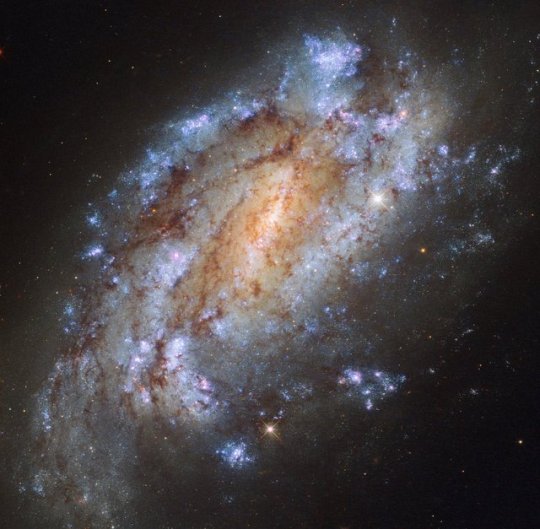
The loneliest firework display
Roughly 50 million light-years away lies a somewhat overlooked little galaxy named NGC 1559. Pictured here by Hubble’s Wide Field Camera 3, this barred spiral lies in the little-observed southern constellation of Reticulum (The Reticule).
NGC 1559 has massive spiral arms chock-full of star formation, and is receding from us at a speed of about 1300 km/s. The galaxy contains the mass of around ten billion Suns — while this may sound like a lot, that is almost 100 times less massive than the Milky Way. Although NGC 1559 appears to sit near one of our nearest neighbours in the sky — the Large Magellanic Cloud (LMC), this is just a trick of perspective. In reality, NGC 1559 is physically nowhere near the LMC in space — in fact, it truly is a loner, lacking the company of any nearby galaxies or membership of any galaxy cluster.
Despite its lack of cosmic companions, when this lonely galaxy has a telescope pointed in its direction, it puts on quite a show! NGC 1559 has hosted a variety of spectacular exploding stars called supernovae, four of which we have observed — in 1984, 1986, 2005, and 2009 (SN 1984J, 1986L, 2005df [a Type Ia], and 2009ib [a Type II-P, with an unusually long plateau]).
NGC 1559 may be alone in space, but we are watching and admiring from far away.
https://www.spacetelescope.org/images/potw
60 notes
·
View notes
Photo
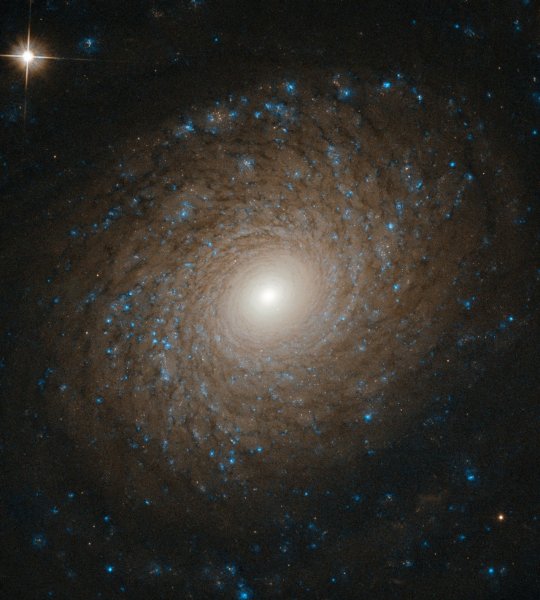
A Beautiful Whorl
Galaxies come in many shapes and sizes. One of the key galaxy types we see in the Universe is the spiral galaxy, as demonstrated in an especially beautiful way by the subject of this Hubble Picture of the Week, NGC 2985. NGC 2985 lies roughly over 70 million light years from the Solar System in the constellation of Ursa Major (The Great Bear).
The intricate, near-perfect symmetry on display here reveals the incredible complexity of NGC 2985. Multiple tightly-wound spiral arms widen as they whorl outward from the galaxy’s bright core, slowly fading and dissipating until these majestic structures disappear into the emptiness of intergalactic space, bringing a beautiful end to their starry splendour.
Over aeons, spiral galaxies tend to run into other galaxies, often resulting in mergers. These coalescing events scramble the winding structures of the original galaxies, smoothing and rounding their shape. These objects possess a beauty all their own, distinct from the spiral galaxies from whence they came.
https://www.spacetelescope.org/images/potw
#space#astronomy#space images#space pictures#astrophotography#space--bot#science#Id#potw1928a#Type#Observation#Release#date#15#July#2019#0600#Size#1889#2100#Name#NGC#2985#Local#Universe#Spiral#Distance#70
8 notes
·
View notes
Photo
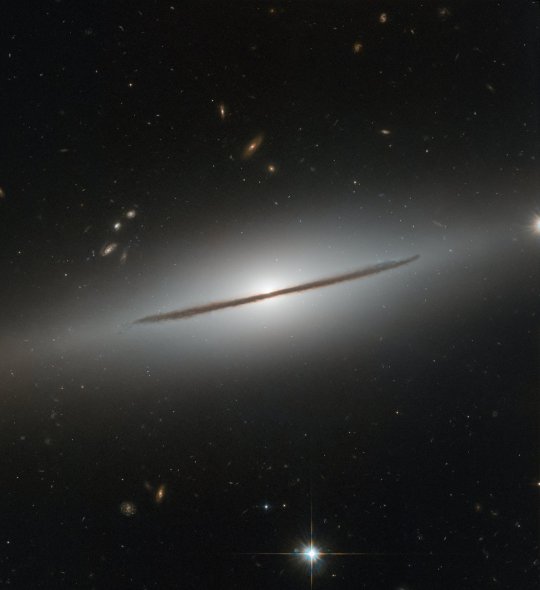
A spiral disguised
Resembling a wizard’s staff set aglow, NGC 1032 cleaves the quiet darkness of space in two in this image from the NASA/ESA Hubble Space Telescope.
NGC 1032 is located about a hundred million light years away in the constellation Cetus (The Sea Monster). Although beautiful, this image perhaps does not do justice to the galaxy’s true aesthetic appeal: NGC 1032 is actually a spectacular spiral galaxy, but from Earth, the galaxy’s vast disc of gas, dust and stars is seen nearly edge-on.
A handful of other galaxies can be seen lurking in the background, scattered around the narrow stripe of NGC 1032. Many are oriented face-on or at tilted angles, showing off their glamorous spiral arms and bright cores. Such orientations provide a wealth of detail about the arms and their nuclei, but fully understanding a galaxy’s three-dimensional structure also requires an edge-on view. This gives astronomers an overall idea of how stars are distributed throughout the galaxy and allows them to measure the “height” of the disc and the bright star-studded core.
https://www.spacetelescope.org/images/potw
#space#astronomy#space images#space pictures#astrophotography#space--bot#science#Id#potw1820a#Type#Observation#Release#date#14#May#2018#0600#Size#3148#3441#Name#NGC#1032#Local#Universe#Spiral#Distance#100
4 notes
·
View notes
Photo
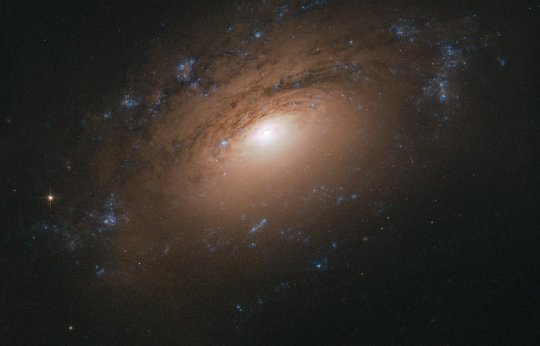
Up and Over
Every now and then, the NASA/ESA Hubble Space Telescope glimpses a common object — say, a spiral galaxy — in an interesting or unusual way. A sharply angled perspective, such as the one shown in this Picture of the Week, can make it seem as if we, the viewers, are craning our necks to see over a barrier into the galaxy's bright centre.
In the case of NGC 3169, this barrier is the thick dust embedded within the galaxy's spiral arms. Cosmic dust comprises a potpourri of particles, including water ice, hydrocarbons, silicates, and other solid material. It has many origins and sources, from the leftovers of star and planet formation to molecules modified over millions of years by interactions with starlight.
NGC 3169 is located about 70 million light-years away in the constellation of Sextans (The Sextant). It is part of the Leo I Group of galaxies, which, like the Local Group that houses our home galaxy, the Milky Way, is part of a larger galactic congregation known as the Virgo Supercluster.
https://www.spacetelescope.org/images/potw
#space#astronomy#space images#space pictures#astrophotography#space--bot#science#Id#potw1929a#Type#Observation#Release#date#22#July#2019#0600#Size#3952#2528#Name#NGC#3169#Local#Universe#Spiral#Distance#70
7 notes
·
View notes
Photo
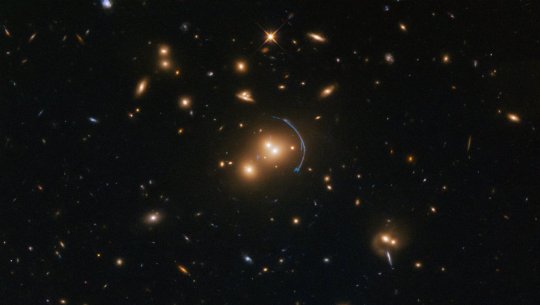
Probing the distant past
Obtained for a research programme on star formation in old and distant galaxies, this NASA/ESA Hubble Space Telescope image obtained with its Wide Field Camera 3 (WFC3) demonstrates the immense effects of gravity; more specifically, it shows the effects of gravitational lensing caused by an object called SDSS J1152+3313.
Gravitational lenses — such as this galaxy cluster SDSS J1152+3313 — possess immense masses that warp their surroundings and bend the light from faraway objects into rings, arcs, streaks, blurs, and other odd shapes. This lens, however, is not only warpping the appearance of a distant galaxy — it is also amplifying its light, making it appear much brighter than it would be without the lens. Combined with the high image quality obtainable with Hubble, this gives valuable clues into how stars formed in the early Universe.
Star formation is a key process in astronomy. Everything that emits light is somehow connected to stars, so understanding how stars form is key to understanding countless objects lying across the cosmos. Astronomers can probe these early star-forming regions to learn about the sizes, luminosities, formation rates, and generations of different types of stars.
https://www.spacetelescope.org/images/potw
#space#astronomy#space images#space pictures#astrophotography#space--bot#science#Id#potw1831a#Type#Observation#Release#date#30#July#2018#0600#Size#3446#1946#Name#SDSS#J1152+3313#Early#Universe#Gravitationally#Lensed#Constellation
2 notes
·
View notes
Photo
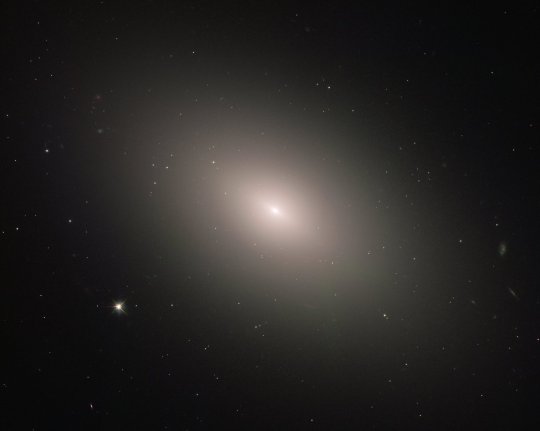
Bucking the trend
This luminous orb is the galaxy NGC 4621, better known as Messier 59. As this latter moniker indicates, the galaxy was listed in the famous catalogue of deep-sky objects compiled by French comet-hunter Charles Messier in 1779. However, German astronomer Johann Gottfried Koehler is credited with discovering the galaxy just days before Messier added it to his collection.
Modern observations show that Messier 59 is an elliptical galaxy, one of the three main kinds of galaxies along with spirals and irregulars. Ellipticals tend to be the most evolved of the trio, full of old, red stars and exhibiting little or no new star formation. Messier 59, however, bucks this trend somewhat; the galaxy does show signs of star formation, with some newborn stars residing within a disc near the core.
Located in the 2000-strong Virgo Cluster of galaxies within the constellation of Virgo (The Virgin), Messier 59 lies approximately 50 million light-years away from us. This image was taken by the NASA/ESA Hubble Space Telescope’s Advanced Camera for Surveys.
https://www.spacetelescope.org/images/potw
#space#astronomy#space images#space pictures#astrophotography#space--bot#science#Id#potw1921a#Type#Observation#Release#date#27#May#2019#0600#Size#3762#3000#Name#NGC#4621#Local#Universe#Elliptical#Constellation#Virgo
1 note
·
View note
Photo
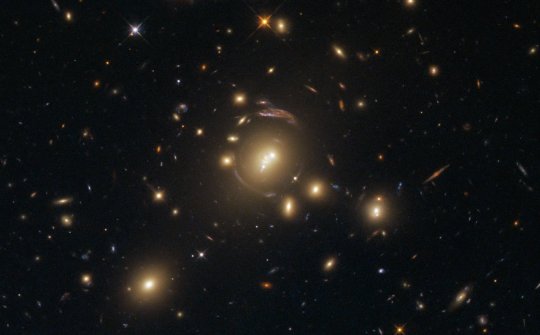
Major mergers
At first glance, it may seem as though this image was taken through a faulty lens, but the mind-bending distortions visible in this Hubble Wide Field Camera 3 impressive image are actually caused by a cosmic phenomenon.
The bright object at the centre of the frame is the galaxy cluster SDSS J1336-0331. The enormous gravitational influence of the cluster warps the very shape and fabric of its environment (the spacetime around it) creating an effect known as strong gravitational lensing. Through this the light from background galaxies in the line of sight to the observer are bent into fantastic arcs. This effect is very useful for studying distant background galaxies.
Moreover SDSS J1336-0331 is interesting in itself: the cluster was part of a study of star formation within 42 of the Brightest Cluster Galaxies (BCGs — the brightest galaxies within their host clusters, as the name would suggest). Typically located in the centres of their clusters, BCGs are among the most massive and luminous galaxies in the Universe. They are generally huge elliptical galaxies and are likely to host active galactic nuclei (AGN) in their cores. The study found evidence to suggest that BCGs are fueled by cold gas from the galaxy. It also showed that star formation in older BCGs no longer significantly contributes to the galaxy’s growth; instead, the stellar growth occurs through mergers, the collision of two galaxies. Violent, gas-rich major mergers can trigger intense bursts of star formation in their aftermath.
https://www.spacetelescope.org/images/potw
#space#astronomy#space images#space pictures#astrophotography#space--bot#science#Id#potw1829a#Type#Observation#Release#date#16#July#2018#0600#Size#3432#2129#Name#6dFGS#gJ133600.1-033130#SDSS#J1336-0331#Early#Universe#Grouping#ClusterEarly
6 notes
·
View notes
Photo
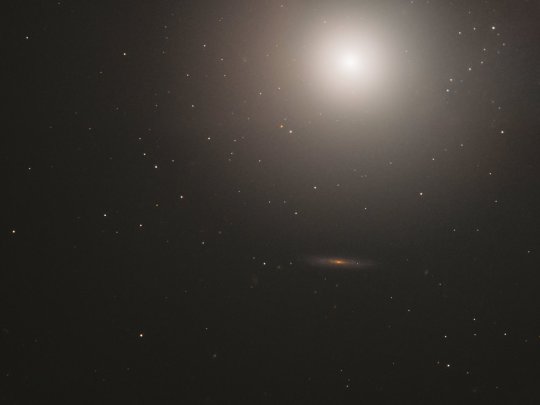
Messier Monday
This huge ball of stars — around 100 billion in total — is an elliptical galaxy located some 55 million light-years away from us. Known as Messier 89, this galaxy appears to be perfectly spherical; this is unusual for elliptical galaxies, which tend to be elongated ellipsoids. The apparently spherical nature of Messier 89 could, however, be a trick of perspective, and be caused by its orientation relative to the Earth.
Messier 89 is slightly smaller than the Milky Way, but has a few interesting features that stretch far out into the surrounding space. One structure of gas and dust extends up to 150 000 light-years out from the galaxy’s centre, which is known to house a supermassive black hole. Jets of heated particles reach out to 100 000 light-years from the galaxy, suggesting that Messier 89 may have once been far more active — perhaps an active quasar or radio galaxy — than it is now. It is also surrounded by an extensive system of shells and plumes, which may have been caused by past mergers with smaller galaxies — and implies that Messier 89 as we know it may have formed in the relatively recent past.
Messier 89 was discovered by astronomer Charles Messier in 1781, when Messier had been cataloguing astronomical objects for 23 years — ever since he mistook a faint object in the sky for Halley’s Comet. Upon closer inspection, he realised the object was actually the Crab Nebula. To prevent other astronomers from making the same error, he decided to catalogue all the bright, deep-sky objects that could potentially be mistaken for comets. His methodical observations of the night sky led to the first comprehensive catalogue of astronomical objects: the Messier catalogue! Messier 89 holds the record for being the last ever giant elliptical to be found by Messier, and the most perfectly spherical galaxy in the entire catalogue of 110 objects.
https://www.spacetelescope.org/images/potw
#space#astronomy#space images#space pictures#astrophotography#space--bot#science#Id#potw1902a#Type#Observation#Release#date#14#January#2019#0600#Size#1425#1069#Name#Messier#89#Local#Universe#Elliptical#Constellation#Virgo
3 notes
·
View notes